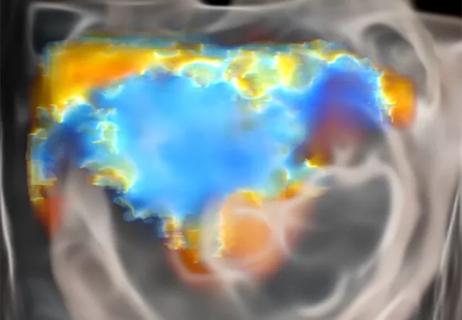Findings support emphasis on markers of frailty related to, but not dependent on, age

A multicenter proteomic study has uncovered proteomic signatures associated with frailty and mortality risk in older adults with severe aortic stenosis undergoing transcatheter aortic valve replacement (TAVR). The findings, published in Aging Cell (2023;22:e13978), highlight the potential of proteomic studies to identify functional biomarkers and potentially druggable biological pathways to improve interventional outcomes in patients with advanced cardiovascular disease.
Advertisement
Cleveland Clinic is a non-profit academic medical center. Advertising on our site helps support our mission. We do not endorse non-Cleveland Clinic products or services. Policy
“We found that integrating comprehensive protein profiling with multidimensional measures of frailty enabled us to define proteomic signatures capturing variability beyond chronological aging alone,” says study co-author Samir Kapadia, MD, Chair of Cardiovascular Medicine at Cleveland Clinic. “Sex and factors like body mass index accounted for more variance in frailty-related proteomic scores than age in our cohort with severe aortic stenosis.”
The research stems from the growing prevalence of individuals with multiple advanced chronic conditions who now survive to old age thanks to improvements in cardiovascular interventions and prevention over recent decades. The result is more and more high-risk patients in whom the interplay between cardiac and noncardiac physiology has substantial impact on the outcomes of potential cardiovascular interventions — and therefore on clinical decision-making around those interventions.
“In these patients, it is crucial to understand how frailty — or impairment of the body’s capacity to maintain homeostasis during physiologic stress — will likely affect treatment response,” Dr. Kapadia explains. “This work advances the growing molecular aging literature into the cardiovascular space in an effort to identify precision medicine approaches that can help bolster physiologic resilience and reduce risk in older adults who may be candidates for cardiac interventions.”
The researchers quantified levels of 979 proteins in blood samples from 809 patients (median age, 83 years) in a multicenter prospective cohort study undergoing TAVR for severe symptomatic aortic stenosis. Frailty measures were systematically collected in all patients. The researchers then related patterns in the quantified proteins to an array of 12 physical, cognitive, nutritional, patient-reported and biochemical measures used to assess frailty status.
Advertisement
Using an integrative analytic approach, the team defined proteomic signatures corresponding to three key phenotypic axes of frailty: patient-reported outcomes, body composition and physical function. Within this “frailty proteome,” the physical function signature — incorporating proteins related to inflammation, muscle function and tissue repair — showed the strongest relationship with mortality after adjusting for clinical risk factors.
The proteomic analysis also pointed to biological pathways not widely described previously as relevant to human frailty, including adipose inflammation, muscle regeneration and lysosomal metabolism.
In contrast to some previous epidemiologic reports, chronological age accounted for only a small fraction of variance in frailty-related proteomic scores in this clinical cohort with advanced cardiovascular disease. “This suggests a greater role for patient-level heterogeneity related to factors such as metabolic-inflammatory phenotype in determining frailty status and outcomes in an older patient population,” Dr. Kapadia notes.
The team next examined the generalizability of their findings by assessing their identified frailty proteome in large published cohorts, including a 35,000-subject community cohort in Iceland and 1,900 community-dwelling Framingham Heart Study participants. They found consistent links to metabolic and inflammatory traits rather than purely cardiovascular outcomes. The physical function signature showed a significant association with all-cause mortality over more than 20 years of follow-up in the community-based Framingham cohort.
Advertisement
“Our study underscores the prognostic relevance of systemic, multi-organ alterations beyond cardiac structure and function that interact to determine clinical trajectories and outcomes in older patients with advanced cardiovascular disease,” Dr. Kapadia says. “The findings point to a need to look beyond the heart and consider adjunctive, personalized interventions to address residual risk related to frailty.”
He says future research steps include evaluating whether the frailty proteome signatures are modifiable with existing or emerging pharmacotherapies and studying their implementation as precision biomarkers to guide therapeutic decision-making in older cardiovascular patients.
The potential implications go beyond interventions for structural heart disease, he notes, with applicability to mechanical circulatory support devices and more. They also apply not just to decisions around whether to intervene but also to which patients should be targeted with more aggressive pharmacologic or rehabilitative therapy after an intervention.
“This is a very interesting line of research that allows for precision analysis to predict frailty in patients undergoing TAVR for severe aortic stenosis,” says cardiologist Milind Desai, MD, MBA, Vice Chair of Education for Cleveland Clinic’s Heart, Vascular & Thoracic Institute. “Given the rapid increase in elderly patients undergoing TAVR, it is incumbent upon us as a society to develop precise markers of frailty that help identify which patients will benefit most from technologies like TAVR and then maximize the benefit they receive. The current paper is absolutely a step in the right direction.”
Advertisement
Advertisement

Cleveland Clinic pioneers a new paradigm in cardiovascular care delivery

Site visits offer firsthand lessons in clinical and operational excellence in cardiovascular care

Cancer drug helps treat decades-long symptoms in patient with complicated lymphatic issue

Findings establish overweight/obesity as a modifiable risk factor for cardiovascular disease

Observational study supports adding CAC score to traditional risk factors for precision medicine approach

Visual snapshots of how we manage challenging cases

Inflammation found more predictive of events than LDL-C in pooled analysis of RCTs

How our HVTI Advisory Services team facilitated swift improvements for an affiliated health organization